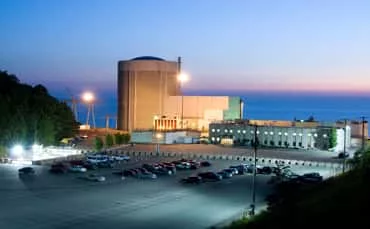Beyond Nuclear and Don’t Waste Michigan, long-time environmental watchdogs on the Palisades atomic reactor, have filed a Freedom of Information Act request with the U.S. Nuclear Regulatory Commission. The FOIA request, filed by the groups’ legal counsel, Terry Lodge of Toledo, Ohio, seeks unredacted versions of Holtec’s February 1, 2023 cover letter, and two enclosures, regarding the “Regulatory Path to Reauthorize Power Operations at the Palisades Nuclear Plant.” NRC has acknowledged receipt of the groups’ FOIA request.
The FOIA request challenges Holtec’s invocation of proprietary trade secrecy, stating:
“The documents sought by DWM and BN are expected to reveal Holtec International’s suggested regulatory steps to bring about the unprecedented reopening and recommissioning of a shutdown, defueled nuclear power plant which is presently being decommissioned. Holtec’s suggested regulatory path to reopen Palisades is bogus. It is of interest to the public because Holtec has no competitor. Palisades is the only closed reactor whose owner is trying to reopen it; indeed, there has never been a similar effort made to reopen a closed reactor. No one is watching the Palisades controversy to learn some clever regulatory trick. There are no genuine prospects for a Palisades restart.”
The groups’ FOIA request concludes that “Releasing unredacted versions of the requested documents will significantly add to public understanding of the NRC’s role in this unprecedented attempt to restore Palisades to operability.”
This is the third FOIA request submitted by the groups in recent months. The first two were submitted in November 2022 to the U.S. Department of Energy (DOE), and the State of Michigan Public Service Commission, for complete documentation on why DOE rejected Holtec’s first federal bailout application on November 18, 2022.
“Since the public is being asked to pay for the Palisades restart, in the form of federal taxpayer bailouts, as well as state subsidies such as above market ratepayer power purchase agreements, the public certainly deserves complete transparency on Holtec’s scheme,” said Michael Keegan, co-chair of Don’t Waste Michigan. “We’re talking potentially billions of dollars in public giveaways to Holtec,” Keegan added.
A breakdown of the costs and complexities associated with restarting Palisades, and the questions they beg, has been prepared by Arnie Gundersen, chief engineer at Fairewinds. His statement is included below. He questions where Holtec is getting the funding from, to pursue its restart scheme. Use of the Palisades Nuclear Decommissioning Trust Fund to do so would not be proper. Gundersen has served as the environmental coalition’s nuclear safety expert witness at Palisades for a decade.
“The off the charts bad safety risks represented by Holtec and Governor Whitmer’s zombie reactor plan means Holtec’s restart strategy needs to be publicly released in its entirety,” said Kevin Kamps, Beyond Nuclear’s radioactive waste specialist. “Pathways to catastrophic meltdown at Palisades include the worst neutron-embrittled reactor pressure vessel in the U.S. and perhaps world, a reactor lid and steam generators that have needed replacement for decades, control rod drive mechanism seals that have been problem-plagued for more than 50 years, and a turbine likely warping under its own weight,” Kamps added.
A 1982 NRC-commissioned study, carried out by Sandia National Laboratory in New Mexico, most commonly known as CRAC-II (short for Calculation of Reactor Accident Consequences, also known as the 1982 Sandia Siting Study, or as NUREG/CR-2239), contained shocking figures for how many casualties would be caused by a meltdown at Palisades, as well as how costly property damage would be. CRAC-II estimated that a Palisades meltdown would cause a thousand peak early fatalities (acute radiation poisoning deaths), 7,000 peak early (radiation) injuries, 10,000 peak cancer deaths (latent cancer fatalities), as well as $52.6 billion in property damage. Adjusted for inflation alone, property damage would surmount $163 billion in 2022 dollar figures. And as AP investigative journalist Jeff Donn reported in his four-part series “Aging Nukes” in 2011, populations have soared around U.S. atomic reactors such as Palisades, so casualty figures would now be significantly worse downwind, downstream, and up the food chain from a meltdown.
NRC has consistently held that the Palisades atomic reactor no longer possesses an operating license. In a July 14, 2022 letter, NRC’s Gregory F. Suber, Deputy Director, Division of Operating Reactor Licensing, Office of Nuclear Reactor Regulation, confirmed to Beyond Nuclear’s Kevin Kamps that:
“The regulation 10 CFR 50.82(a)(2) states the following:
Upon docketing of the certifications for permanent cessation of operations and permanent removal of fuel from the reactor vessel, or when a final legally effective order to permanently cease operations has come into effect, the 10 CFR part 50 license no longer authorizes operation of the reactor or emplacement or retention of fuel into the reactor vessel.”
And a Feb. 7, 2023 ExchangeMonitor article, entitled “To restart shuttered Palisades plant, Holtec would need to start ‘from scratch,’ NRC commissioner Crowell says,” reported:
As for NRC’s role in a potential restart, Crowell — who joined the commission in August — said it would be difficult for the safety regulator to prepare for such a development because of the uncertainty surrounding Palisades’ fate.
“I feel like it’s difficult to get our ducks in a row for that because it changes almost on a monthly basis,” Crowell said. “I understand they [Holtec] are in a posture of wanting to find a buyer to do it… but I think at this stage of the game, you’re gonna have to start from scratch.”






